Making your own products takes energy, determination and talent – but it’s not hard to see why more and more creatives are taking up the challenge. The market for design-led products is booming, and the choice of objects you can create is bafflingly broad.

Bouf’s range of products includes these Motorway plates by Snowden Flood, and handpainted mugs based on portrait photos, by House of Harriet.
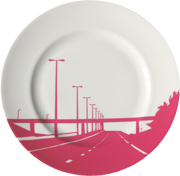
Illustrators of all levels of fame can transform their designs to postcards, wallpaper, screen-printed posters, mugs, badges, laptop cases, wall decals, homewares, vinyl toys, T-shirts and other apparel, and far more – and such products meet an eager and growing audience.
For creatives, the benefits are obvious. Creating products offers a chance to get your work seen by new audiences. An eye-catching product can be a great way for illustrators to build their profile – and hopefully make some money while they do so.
Here are 10 tips to get you started.
TIP ONE – Team up
When you’re just starting out, getting products made can be hard: collaborating with an independent craftsman can be a good way to get off the ground. Whether it’s jewellery, furniture, or a beaded screen where each bead is a laser-cut character, a skilled pair of hands and an extra brain could help you decide whether your idea’s a winner or a flop, and help get your dream made, marketed and sold – or you could end up making something completely different thanks to their input.
As with all partnerships, find someone you get on with and trust. Design fairs, festivals and product design graduate shows are all good places to hunt for up-and-coming, collaboration-minded talent.
Boreal is a three-strong company that makes limited-edition, handmade illustrated vinyl wallets (boreal.org.uk). Art student Stephen Gibbs came up with the concept, frustrated at the lack of ‘imagination and ingenuity’ in men’s fashion. He teamed up with fashion designer Sally Smallwood and graphic designer Chris Barter to design and launch the product; Smallwood initially hand-sewed all the wallets herself. Boreal has since developed a thriving community of artists who contribute illustrations for the wallets.
TIP TWO – Play with the form
Henrietta Swift’s project is a deceptively simple set of stickers called Light Up your Mood (henriettaswift.com). You stick them onto your light switches however you choose, adding a little personality to what is normally a dull bit of a room. It’s a quirky little product that cleverly uses something everybody already has lots of.
She says: “The Young Creatives Network [a creative agency] set me a task to create something to cheer them up for £10. I had the idea of changing all the light switches in the building to happy faces, and stickers seemed to be the best approach.”
Many of the best – and most eye-catching – illustrator-made products work because they move beyond being simply pictures adorning objects: they play with the format. Witness the recent mini-explosion of gloves, mugs, pencils and even dog toys that make the user (or wearer) look as though they have a flourishing weightlifter-style moustache, or Mathieu Herbert’s competition-winning badge for Stereohype, which mimics a Victorian cameo brooch, or DecoSticks’ wall decal for Bouf, which adds a procession of giant ants to your skirting board.
This interaction with the real world is part of the reason that creating products – whether in collaboration or alone – is so exciting for illustrators: it offers them a chance to move beyond the screen and sketchbook and into three dimensions.
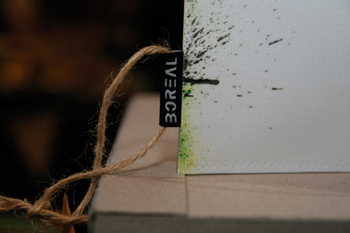
Above and Right: To create the Boreal range of illustrator-designed wallets, Stephen Gibbs enlisted the help of a fashion designer and spent months perfecting the designs. He says: “One of the best methods for improving our product was using the wallets as we would in the real world.”
TIP THREE – Start a chain reaction
Down to the nitty-gritty: you’ll need to find the right materials – whether blank T-shirts or the perfect type of Perspex – help with making the product, and a way of selling it. Getting great suppliers, craftspeople and distributors takes serious legwork.
Contact potential distributors early: speak to design boutiques, online independent design stores, independent galleries and so on. They know what sells, and their input could be crucial in helping refine your product. They may be able to recommend manufacturers or suppliers who specialise in illustration-led projects. Some companies, such as Clickforart, even handle the process for you, taking artists designs and producing them as limited-edition cushions, screen-prints, cup-and-saucer sets, and more.
Henrietta Swift says that for her sticker sets, some research led her to the right manufacturer. “I found a great company, Diginate (diginate.com) who produce one-off contour-cut stickers: they’re who I used for my first batch. I then contacted them when we were considering a larger run and they gave a reasonable production price, so we stuck with them.”
If your product is complex then getting the right materials can be challenging: Boreal found that it took days of trekking around fabric shops and markets and scouring the internet to request samples from digital printers. “We needed a fabric which could not only cope with day-to-day usage, but could show off highly colourful and detailed artwork,” says Stephen Gibbs.
Fashion designer Sally Smallwood spent weeks testing different threads and ways of sewing them, says Chris Barter. “A lot of the materials were ruled out straightaway due to the edges fraying, or us not having the machinery to cope.”
Finding the right fabric took the Boreal team months, but perseverance and effort saw them through.
TIP FOUR – Be rare
There’s nothing wrong with not achieving world domination, particularly at first: go for small editions of your products when you’re starting out.
“[Your product] has to be producible as one-offs or small editions to keep the risk to a bare minimum while finding out whether there is any demand for it,” says Tomi Vollauschek, who runs online design boutique Stereohype (stereohype.com), as well as design studio FL@33. “If demand is indeed high then bigger editions should be possible.”
Darren Riley of Clickforart (clickforart.com) says that “being bold and quickly learning from mistakes” is a good skill for creatives to pick up – and again, this is easier to accomplish if you’re not stuck with a mountain of stock to distribute.
Plus, of course, if your creation is very limited-edition, this means that it will be even more collectible – and valuable – when you’re rich and famous in 20 years’ time.
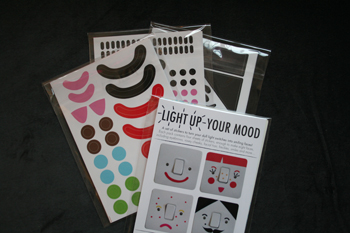
TIP FIVE – Aim wide
“A lot of products designed, produced and directly sold by graphic designers and illustrators themselves tend to have their peers in mind as potential customers,” says Vollauschek. “To reach out of this limited market must of course be the ultimate aim – how many products can you possibly sell to your potential competitors?”
He has a point: while a mug with a typographic in-joke might garner attention in design blogs and magazines, and win the approval of your mates and colleagues, its appeal won’t stretch significantly further.
This doesn’t mean aiming for focus group-style sterility or mass audiences, and it doesn’t mean giving up that lovingly created, quirky feel that many illustrator-led products have. But some careful thought about who your ideal customer is will stand you in good stead, as will some lateral thinking about what possible gaps there are in the market.
For example, if you’re spotting customised laptop bags just like the one you’ve created all over the place, but friends who’ve just had a baby are complaining that all the baby-related stuff they can find is far too chintzy, then you may well have found a niche.
This is how Boreal wallets came about. Stephen Gibbs explains: “I found myself frustrated with the lack of variety in the fashion industry for men, and in particular the lack of imagination and ingenuity. I was always on the lookout for something a little bit different that was unique. It was from this lack and gap in the market that Boreal came about.”
TIP SIX – Shout about it
The good news is that there are more ways to get your product into customers’ hands than ever before. There are traditional routes such as design fairs and events such as the Designers Marketplace (designersmarketplace.com), gift shops, art galleries, and design boutiques.
Now creatives can also sell goods through online portals such as Etsy, which hosts the work of thousands of creatives internationally, from jewellery to papercrafts, or Bouf, which is UK-based – and even eBay. Many also sell their products through their own sites.
The bad news is that there are other kooky vinyl toys, T-shirts, cushions, postcard sets and wall decals out there: you have to shout to get your product noticed.
The biggest favour you can do yourself is getting very good high-res photos of your product: you’ll need general photos of the product against a plain background, showing exactly what it looks like, and more imaginative close-ups focusing on details, or showing the product in use. A good set of images will help capture the attention of potential stockists and buyers alike – and boost your chances of getting into magazines and blogs.
You’ll also need to contact all the blogs and magazines you can think of with a clear outline of what your product is and why it’s brilliant (along with the price, where people can buy it, and those lush photos).
Get in touch with both design shops and local independent shops of all kinds. So if your work has kid-friendly animals then children’s shops might be interested; if you’re making hip T-shirts then try skatewear or record shops. Pitching your work takes tenacity and thick skin: don’t let a couple of rejections get you down.
There’s even more work to be done online, and for this you’ll need a little help from your friends. Set up a Facebook fan page, a Twitter account, give it pride of place on your blog, and email every relevant contact you have letting them know about it.
TIP SEVEN – Be different
As with all artistic ventures, products that are born out of their creators’ raw imagination and are unlike anything else on the marketplace will capture the imagination of buyers far more readily than those that resemble products that are already available.
Originality is key – and the fact that you’ve had an idea doesn’t mean that nobody else has got there first. Scour the marketplace before getting stuck in to prototyping, just to make sure your project really is an original.
“Check out the competition – and then never copy anything they do or did,” says Stereohype’s Tomi Vollauschek, adding that he has seen plenty of pieces that rip off existing products, whether knowingly or unwittingly. This is not the way to make friends in the close-knit design community, and can even land you in legal trouble.
Another reason for beating your own path is in the very nature of illustrator-led products: the people who hunt out these goods do so because they want something exclusive, unusual and away from the mainstream. They prize originality and creativity, and are prepared to pay a premium for products with design flair. You won’t win their cash with run-of-the-mill designs.
“We want our customers to be free to express their individuality, with products that they couldn’t easily find elsewhere,” says Alex Griffin, who runs online design network Bouf.
TIP EIGHT – Do your sums
Unless you’re lucky enough to partner with someone who will handle all the manufacturing and distribution, you’ll have to spend money to make money: this means keeping a close eye on the bottom line.
Consider cost from the very beginning, factoring in the materials, manufacture, storage and even postage to see if the figures stack up.
Pricing is crucial, as Bouf’s Alex Griffin underlines: “Customers are extremely price-sensitive: the items that sell best are those that have their manufacturing process perfected, so that pricing is realistic and accurately reflects what customers are willing to pay,” he says.
Stereohype’s Tomi Vollauschek recommends some straightforward road-testing to gauge your pricing: “Ask as many diverse people as possible whether they like your ideas, whether they would buy it, and how much they would be willing to pay,” he says.
The wait for your outlay to pay off can be painful. “Be aware that you will inevitably end up having lots of pounds worth of your products lying around in boxes and postal tubes waiting for customers to give you their hard-earned cash – it’s an investment,” Vollauschek says.
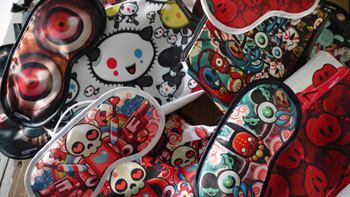
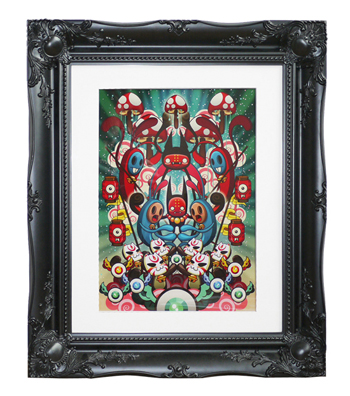
Clickforart works with creatives to produce teacups, cushions, screen-prints and more featuring their illustrations.
TIP NINE – Respect the limits
Creating real-world products isn’t as simple as plonking a Photoshop image onto a canvas, mug or other item: you need to be aware of the manufacturing process – and its limitations.
For example, with screen-printing, each colour is applied individually, so the cost and chance of errors rises with each extra colour you use. This will have a drastic impact on your designs for T-shirts, art posters or any other screen-printed product.
Talk to your manufacturer and hone your design to make the manufacturing process as simple as possible – this usually has the extra benefit of being more cost-effective.
“We found that the most successful approach was to keep things simple: we always try to over-complicate things and end up going back to basics,” says Stephen Gibbs of Boreal.
TIP TEN – Be nice
This bit’s really, really important. When you’re designing, making and selling your own products you will need the goodwill and enthusiasm of others at every link of the chain, so it’s worth keeping people on-side.
“We made a point of building a good working relationship with the printer, because as we were still in the experimenting stage we were going to need lots of test runs – which they were very helpful with,” says Boreal’s Chris Barter.
Invest time in establishing relationships with boutique owners, local independent businesses such as bookshops, art galleries, online stores, craftspeople, possible manufacturers, and anyone who might champion your work.
Listen to what they’re after and see if you can meet their needs; ask for their feedback on your designs and take what they say onboard. Shops and organisations are also much more likely to back your project if you’ve invested time in them.
And finally, don’t be shy. Get out there and shout about your work: show it off to your family, friends and colleagues – they’re the closest you’ll come to a focus group at first, and even if you don’t agree with what they say they’ll give a valuable outsiders’ view of something you might have been slaving away on for months.
Your family and friends are also the closest thing you’ll get to a cheerleading squad in those tough early months: a little charm with them – and some free samples – will go a long way.
Alice Rose
Source: Digital Arts




